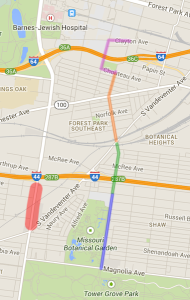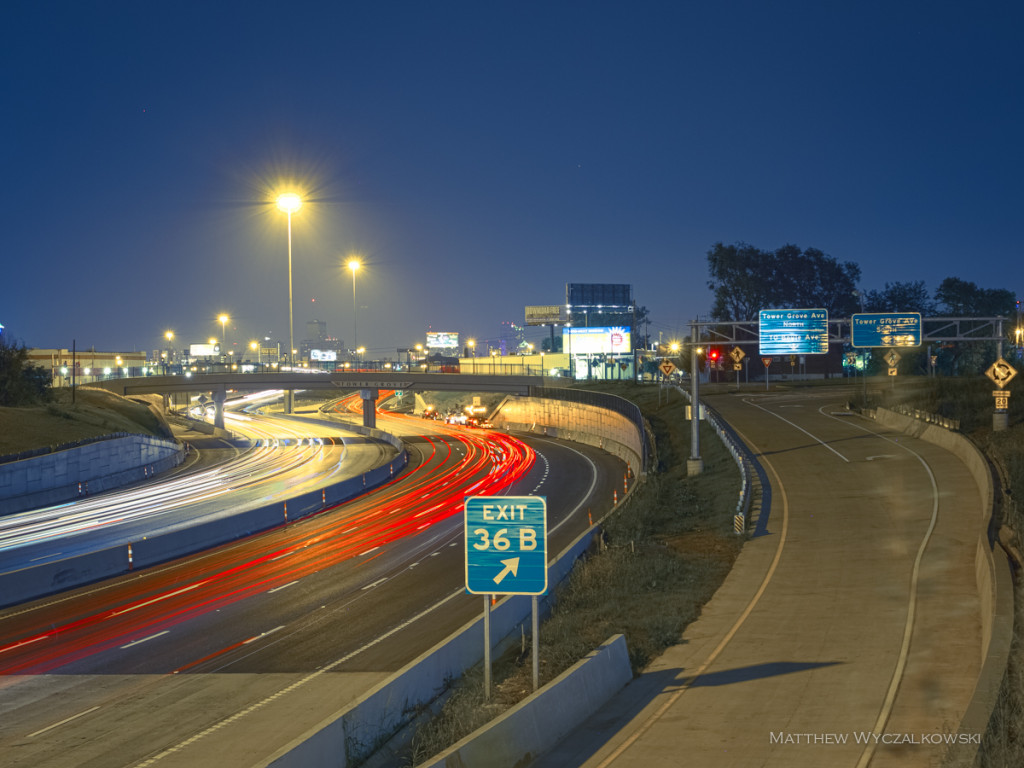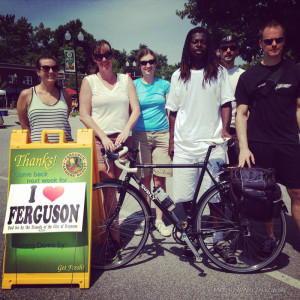Last week we wrote about cycling hazards on Tower Grove Avenue when Kingshighway closes for a year and a half. We are pleased to have heard back from Emma Klues, Communications Director for Great Rivers Greenway. Emma wrote the following on behalf of Bike St. Louis partners Great Rivers Greenway and the City of St. Louis:
Cycling TGA when Kingshighway Closes: Our Response to City Plans
What Will Happen to Cyclists when Kingshighway Closes?

Tower Grove Avenue. The road, mapped above with colored lines, runs north from Tower Grove Park to the Cortex District and the Central West End. The South Kingshighway Viaduct, highlighted in red, is being rebuilt. In this post we are focusing on southern Tower Grove Avenue (blue and green sections above) when Kingshighway closes. (Click map for details.)
UpdateYou can find the latest details about the City’s proposal for Tower Grove Avenue here, and a petition to voice your concerns here.
In the Fall of 2014 a section of Kingshighway Boulevard – a major St. Louis arterial – will close for a year and a half to rebuild a bridge, and a lot of cars will need to find alternative routes. What will happen to cyclists on Tower Grove Avenue, a principal north/south cycling corridor a half mile to the east? The City has in its hands plans to build bike lanes which would preserve bicycle safety on this route, but those plans are being scrapped to maximize traffic flow – no matter the cost to the road’s cyclists, pedestrians, and neighborhoods.
Read more ›
I-64 Interchange at Tower Grove Ave opens

The I-64 interchange at Tower Grove Avenue is open to traffic: a view of the Tower Grove Avenue overpass at I-64, looking east from the new Boyle bridge.
The Tower Grove Avenue overpass at I-64 opened to traffic on August 29, 2014.
Cycling Fatality Spurs Calls to Action
It has been a month since cyclist Rick Beard – a veteran, entrepreneur, and father of three – was killed by a car while riding in St. Louis. The accident prompted debate and demonstrations, and has led to a push by cycling advocates for City policies to make St. Louis safer for cyclists and pedestrians. While the City has made real strides in the last several years, there is much that remains to be done. Read more ›
SafeTGA Portrait Series
In May 2014 SafeTGA participated in the Tower Grove Better Block Project, where we exhibited a collection of photos illustrating the diversity of cyclists and pedestrians around Tower Grove Avenue. We spoke to a wide range of people to learn about their motivation for alternative modes of transit and concerns about safety and connectivity. The images speak to the variety of cyclists and walkers on Tower Grove Avenue and underscore the unmet potential of this key St. Louis corridor.
We will be exhibiting the photos again at the Missouri Botanical Gardens Green Homes Festival Saturday June 7, 9 a.m. to 4 p.m.
SafeTGA at the Tower Grove Better Block Project
This event has already occurred.
On Saturday May 10 from noon to 4 the Better Block Project transformed a block of Morganford Avenue into a bustling pedestrian and commercial destination with music, art, and food. SafeTGA participated and exhibited a collection of photographs and testimonials to showcase the diversity of pedestrians and cyclists in the Tower Grove neighborhood.
Cortex Transit Oriented Development Study: SafeTGA
The Cortex life sciences district in the heart of St. Louis aims to attract world-class scientists and entrepreneurs by building a vibrant, connected, transit-oriented neighborhood. The recently released Cortex Transit Oriented Development Study (TOD) analyzes the impact of a proposed new Metrolink station on pedestrian and bicycle connectivity, with a particular emphasis on the Tower Grove Avenue (TGA) corridor. There is much to like about this study as it pertains cyclist safety along TGA (which is our focus here), but a few specific recommendations are inappropriate and should be reconsidered.
Read more ›
Complete Streets: St. Louis County Council testimony
Below is testimony we presented to the St. Louis County Council in support of the Complete Streets legislation. You can read more about Complete Streets in our previous post, a comprehensive MoBikeFed story, and the bill itself.
Testimony presented to St. Louis County Council 1/14/14
My name is Matthew Wyczalkowski and I would like to thank you for the opportunity to speak in support of the Complete Streets legislation. I am a resident of St. Louis City, and have been for over a decade. After finishing my PhD in Biomedical Engineering at Washington University, I had the opportunity to move to a variety of cities, and an important consideration was the quality of life. I am an experienced cyclist – I rode as a kid, raced in college, and commute by bike every day – and having the option to ride to work was a definite consideration when I chose to remain in St. Louis. (I now work as a scientist at the Washington University School of Medicine.) Cycling gives me exercise, clears my mind, saves money, and connects me with the community. I have many friends and co-workers who feel this way too.
About a year ago, poorly planned construction along my daily route created serious hazards for cyclists. That road – Tower Grove Avenue – is the busiest bicycle corridor in St. Louis. Sparked by frustration and a fear for my personal safety, I started the SafeTGA blog (which stands for Safe Tower Grove Avenue) to advocate for safer bicycle infrastructure and to encourage a dialog with other cyclists. I have learned a lot about the state of cycling in St. Louis since, and I welcome you to visit the blog for more details.
One thing I learned is that the overwhelming majority of cyclists I spoke to — and I’ve talked to many of them — believe just like me that bike lanes and other infrastructure make cycling safer and encourage more people to ride. My next door neighbor, for instance, started riding his bike to work only when bike lanes were installed on a stretch of Tower Grove Ave — he told me he he had never considered riding to work before those lanes gave him a place on the road.
I also learned that there is a small but loud community of cyclists who oppose most if not all bike infrastructure. I am a fair minded person, and to learn more about their perspective I attended the Cycling Savvy course taught by Karen Karabell, who I understand has testified here in the past. I found that the course is useful for novice riders and teaches basic urban cycling tactics. The course does not, however, provide any sort of guidance or vision for how to build roads which are safe for cyclists, any more than knowing how to drive makes you a civil engineer.
I do have degrees in engineering, and have tried to put them to use by riding on, photographing, and writing about new bicycle infrastructure being installed in St. Louis. Designing good infrastructure is hard, and my aim is to provide feedback to help make it better. I recognize some mistakes will be made now and again, but that is no reason to stop trying to make our roads safer for cyclists. The return on investment is simply too great.
People have a real desire for alternatives to the car – to walk, ride their bike, to take public transit. I feel that way, and I know I’m not alone. All too often, though, we live in a built environment which makes anything but driving inconvenient, uncomfortable, or unsafe. Complete Streets recognizes that roads are not just for cars, and driving is not the only way to get around. It offers the prospect of real choices in how we travel and live. Complete Streets may not be perfect, but it is a step in the right direction. I urge you to support it.
Complete Streets
Much has been written in the last few months about the Complete Streets legislation being considered by the St. Louis County Council, whose aim is to encourage the County’s Transportation Department to include more pedestrian and bicycle-friendly elements in road construction. See the bill and read stories by the St. Louis Post-Dispatch, St. Louis Beacon, Trailnet, and the Missouri Bicycle Federation. Read also a Post-Dispatch editorial opposing Complete Streets as well as a rebuttal by Alderman Scott Ogilvie.
A recent Post-Dispatch story features Karen Karabell, a St. Louis bicycle activist who argues against Complete Streets. (We’ve written about discussions with Ms. Karabell here and here.) The enthusiasm of Karen Karabell’s opposition to Complete Streets today makes her full-throated support of past Complete Streets legislation quite surprising.
In 2009, Karen Karabell worked hard to promote the federal Complete Streets bill and flew to Washington DC to lobby for it in person. She encouraged readers of a local cycling mailing list to write their elected officials with the following talking points (see complete email):
- Complete streets policies ensure that the needs of all users of the transportation system–motorists, transit vehicles and riders, bicyclists, and pedestrians of all ages and abilities– are taken into account when streets are built or re-built. Over 90 states and communities already have complete streets policies, which are flexible and cost-effective.
- Complete streets improve safety, especially for children and older Americans. And if we are serious about ending our dependence on foreign oil, combating climate change, stemming obesity, and revitalizing communities, we need to build roads designed for all users, not just cars.
- Complete Streets don’t cost more to build; in fact, they generate revenue by increasing property values and promoting economic development. They save money by reducing transportation and healthcare costs.
Why has Karen Karabell changed her position on Complete Streets so radically? We don’t know. Everyone is entitled to their opinions, of course, as well as a right to change them. Still, those who assert for themselves public leadership acquire also a responsibility – at a minimum – for the appearance of thoughtfulness and consistency. Advocating opposite solutions to the same issue with equal zeal and enthusiasm, without acknowledgement or explanation of the contradictions, is a troublesome trait for an activist.

